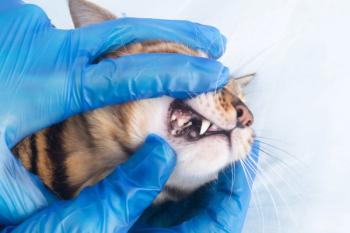
Metered dose inhalers now popular in treating feline asthma
Feline asthma is defined as a chronic inflammatory disease of the lower airways that results in cough, wheeze and exercise intolerance.
Feline asthma is defined as a chronic inflammatory disease of the lowerairways that results in cough, wheeze and exercise intolerance.
Feline asthma appears to be clinically similar to human asthma. In humans,treatment with inhaled medications administered via metered dose inhalersis routine. These metered dose inhalers (MDIs) are often used in combinationwith a device referred to as a "spacer" which allows medicationto be dispersed into a chamber before inhalation. Spacers used in combinationwith small masks make it possible to administer inhaled medications to infantsand very small children.
The use of MDIs in combination with spacers and face masks is now gainingpopularity in the treatment of feline asthma.
Diagnosis, classification
The diagnosis of feline asthma should be based on the presence of severalcriteria including a history of chronic cough or history of sudden onsetof labored breathing that improves with administration of oxygen, bronchodilatorsand/or glucocorticoids; radiographic findings consistent with bronchialwall thickening; and airway cytology characterized by a predominance ofeosinophils and absence of evidence of infection and parasitism.
In a recent article in Veterinary Clinics of North America, Dr. PhilipPadrid has suggested a classification scheme for cats diagnosed with felineasthma (Padrid, P. Feline Asthma: Diagnosis and Treatment. In Vet Clin NorthAm Small Anim Pract 30: 1279 1293, 2000). This scheme may be usedto guide medical therapy:
· Mild asthma. Signs are mild and do not affect the cat's qualityof life. Appetite and activity is normal between episodes.
· Moderate asthma. Signs are intermittent but frequency or durationof signs are such that the patient's quality of life (appetite, activityand/or sleep) is affected.
· Severe asthma. Signs are persistent and evident even at rest.
Therapeutic goals
It has been established in humans that asthma is characterized by chronicinflammation of the airways even in the absence of clinical signs.
For this reason, bronchodilators are seldom used as the sole therapyfor human asthma. While bronchodilators may control clinical signs, airwayinflammation persists and there is the potential for this chronic inflammationto result in irreversible airway damage. A research abstract presented atthe 2001 ACVIM Forum (Norris, CR. Cytokine profiles in peripheral bloodmononuclear cells and bronchoalveolar lavage cells in cats with experimentalfeline asthma) documented the increase in inflammatory mediators associatedwith experimental allergic airway disease in the cat.
As in human asthma, it would therefore seem important that treatmentnot only control the clinical signs but also minimize airway inflammation.
In the past, oral corticosteroids and bronchodilators have been the recommendedtherapy for feline asthma but, while oral medication can accomplish thedesired therapeutic goals, there can be unwanted systemic side effects.
In humans, systemic side effects are minimized and therapeutic efficacymaximized by using inhaled medications. Padrid has suggested that theseinhaled medications can also be efficaciously delivered to feline patients.
In his article, Padrid suggests using a spacer device with a small animalanesthesia mask attached to the end.
In my practice, I have had good results using a small OptiChamber facemask with the Optichamber spacer. I recommend that the client acclimatetheir cat to the apparatus before they begin to administer medication byattaching the mask to the chamber and placing the mask over the pet's facefor short periods of time. Once the pet can tolerate the face mask for sevento 10 breaths, medication can be administered through the chamber.
In order not to startle the cat, I recommend that the inhaler and Optichamber,apparatus be held away from the patient and the inhaler depressed to releasemedication into the chamber. The face mask should be immediately positionedover the cat's nose and the cat allowed to take seven to 10 breaths.
According to Padrid, therapy for asthma in the cat should be based onthe previously described classification scheme. If the patient's clinicalsigns are mild, two puffs of Fluticasone propionate (Flovent,) 110 µgtwice daily are recommended. Albuterol 90 mg (Ventolin, Proventil) may beused as needed but will not likely be required long-term. If the patient'sclinical signs are moderate, oral prednisone at a dose of 1 mg/kg twicedaily for five days and then daily for five days should be prescribed alongwith 220 µg Flovent, twice daily. Again, Albuterol should be usedas needed.
If the patient's clinical signs are severe, treatment should initiallyinclude a parenteral glucocorticoid such as dexamethasone combined withAlbuterol 90 mg administered every 30 minutes until the clinical signs abateor a total of eight doses is reached. Once stable, medical therapy shouldbe the same as for those patients with moderate signs with the exceptionof administering Albuterol four times daily or as needed.
Summary
The use of inhaled medications appears to be a reasonable approach tothe treatment of feline asthma.
It can be inferred from what is known about asthma in humans that thisapproach minimizes systemic side effects while achieving desired therapeuticresults.
Unfortunately, studies that look critically at the effects of inhaledmedication in the cat are lacking. However, in my experience and the experienceof others using these medications, clinical response is often good.
Newsletter
From exam room tips to practice management insights, get trusted veterinary news delivered straight to your inbox—subscribe to dvm360.



